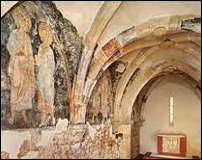Arts
Hungarian art stems from the period of the conquest of the Carpathian basin by the people of árpád in the 9th century.
The People of árpád used beautiful ornamental motifs to decorate both their dress and the trappings of their horses, the main motif being the palmette.
This style remained important in Hungary from the 9th to the 11th centuries.

During this period the combination of styles of the European Romanesque produced a rich heritage, with noticeable parallels in the art of the Scandinavian Vikings and the Celts of Western Europe.
The coronation mantle of King Stephen (crowned 1000 A.D.) is a particularly fine example from this period.
Hungarian art history also has over 550 buildings decorated with medieval and early Renaissance frescoes.
Fresco painting in Hungary followed the deco of European art.
The earliest frescoes from the Romanesque period were influenced by Italian, and Byzantine paintings.
During early Gothic period, frescoes were shaped by French influences, and later by German and Czechs.

The earliest set of frescoes can be found in the Lower Church of Feldebrö and the royal castle of Esztergom The royal castle of Esztergom was rebuilt at the turn of the 12th century.
 The castle’s Chapel with its French taste was decorated with Gothic frescoes.
The castle’s Chapel with its French taste was decorated with Gothic frescoes.

While the apostle frescos made in the mid-13th century can be found in the lower part of the Gizella-chapel in Veszprém.
These frescos definitely reflect the Byzantine and Italian arts.
Romanesque frescoes in churches of smaller villages are different in style and often reflect the epic forms with folk characters.

The Gothic style in 14th century Hungary continued throughout the reigns of the Anjou, Luxembourg, and Jagello kings.
The rich heritage of paintings in Hungary originated with the royal houses of Luxemburg and Anjou, with lineage to king Ladislaus I.
Renaissance art evolved in the city state of Florence around 1420 and it appeared north of the Alps in the early 16th century.
King Matthias Corvinus of Hungary had close ties with Italy, and Italian influence is clearly evident in architectural complexes built during his time including his palaces in Buda and in Visegrad.
The Renaissance supported by King Mátyás extended to the leader stratum of the country.
The prelates and nobility quickly adopted the new style, but it became popular among the middle classes as well.
The most beautiful Renaissance relic of Hungary is the Tuscan architecture located in the Bakócz chapel in Esztergom built in 1507.
The architect/artist was Bakócz Tamás.

The Hungarian Renaissance extended further during the reign of Matthias's Jagellonian successors and flourished in parallel with the emergence of the Baroque until the end of the 17th century.
The altarpiece Nagyszombat (c. 1640) is perhaps the greatest work of the Hungarian Baroque art.
Other prominent artists of the late 17th and 18th centuries were portrait painters Ĺdám Mányoki (1673 – 1757) and Jakab Bogdány (1660 – 1724).

Another famous Hungarian panoramic painter was Árpád Feszty.
His most famous work is entitled "The Arrival of Hungarians" (often called "Feszty Cyclorama") showing the arrival of seven Magyar tribes in 896.
The painting was completed during the height of the Austrian-Hungarian Empire in 1892-94.
The 18,944 square foot cyclorama depicts approximately 2000 characters.
Another form of Hungarian Art is pottery.
In the beginning of the eighteenth century, the present style of Hungarian folk art took shape by incorporating both Renaissance and Baroque elements.
Hungarian Folk art was greatly influenced by different traditions such as Swabian, Serbian, Romanian and Slovakian, depending on the area, as well as Persian Sassanid influences.
Flowers and leaves, sometimes a bird or a spiral ornament, are the principal decorative themes.
The most common ornament in pottery is a flower, with a centerpiece resembling the eye of a peacock's feather.
The folk art of Hungary emerged from the works of the people living in rural areas.
These people were skilled in the making of woodcarvings, wall paintings, basket making, and egg painting.
Pottery was almost always decorated and was used as a valuable gift for decorations in weddings and ceremonies.
The couple's name was often painted on the pottery dishes.
The famous pottery centers in Hungary are Kalocsa, Hodmezovasarhely, Mezotur and Tiszafured.
Each of these centers had a unique feature of its own.
Black pottery was typical of the Nadudvar center, while Mezotur was famous for its Ochre water jars that were glazed and bright.

The finest achievements in the textile arts are the embroideries which vary from region to region.
Those of Kalotaszeg in Transylvania are charming products of Oriental design, sewn chiefly in a single color - red, blue, or black.
Soft in line, the embroideries are applied on altar cloths, pillow cases and sheets.

Kalocsa needlework also ranks high in popularity.
"Writing women" in this town on the Danube in Southern Hungary draw their designs on white or pastel colored fabrics.
Daisies, marigolds, cornflowers, poppies, lilies, tulips and roses furnish the colorful motifs.
Kalocsa designs are also applied to wall decorations.

In the Sárköz region, the women's caps show black and white designs as delicate as lace and give evidence of the people's wonderfully subtle artistic feeling.
The embroidery motifs applied to women's wear have also been transposed to tablecloths and runners suitable for modern use as wall decorations.

Matyó folk embroidery, originating in Mezökövesd, is popular both within Hungary and abroad.
Shawls, tablecloths and aprons of black material are thickly embroidered with a dense accumulation of multicolored flowers in rich Oriental colors which harmonize despite their gaudiness.
|